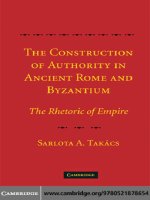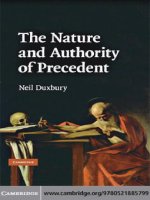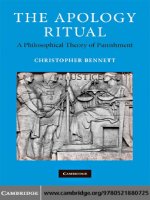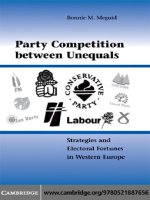cambridge university press the nature and authority of precedent jun 2008 kho tài liệu bách khoa
Bạn đang xem bản rút gọn của tài liệu. Xem và tải ngay bản đầy đủ của tài liệu tại đây (1.17 MB, 206 trang )
THE NATURE AND AUTHORITY
OF PRECEDENT
Neil Duxbury examines how precedents constrain legal decision-makers
and how legal decision-makers relax and avoid those constraints. There
is no single principle or theory which explains the authority of precedent
but rather a number of arguments which raise rebuttable presumptions
in favour of precedent-following. This book examines the force and the
limitations of these arguments and shows that although the principal
requirement of the doctrine of precedent is that courts respect earlier
judicial decisions on materially identical facts, the doctrine also requires
courts to depart from such decisions when following them would perpetuate legal error or injustice. Not only do judicial precedents not
‘bind’ judges in the classical-positivist sense, but, were they to do so, they
would be ill suited to common-law decision-making. Combining historical
inquiry and philosophical analysis, this book will assist anyone seeking to
understand how precedent operates as a common-law doctrine.
NEIL DUXBURY
is Professor of Law at the London School of Economics.
T H E N A TU R E A N D
AUTHORITY OF PRECEDENT
NEIL DUXBURY
CAMBRIDGE UNIVERSITY PRESS
Cambridge, New York, Melbourne, Madrid, Cape Town, Singapore, São Paulo
Cambridge University Press
The Edinburgh Building, Cambridge CB2 8RU, UK
Published in the United States of America by Cambridge University Press, New York
www.cambridge.org
Information on this title: www.cambridge.org/9780521885799
© Neil Duxbury 2008
This publication is in copyright. Subject to statutory exception and to the provision of
relevant collective licensing agreements, no reproduction of any part may take place
without the written permission of Cambridge University Press.
First published in print format 2008
ISBN-13 978-0-511-39484-3
eBook (NetLibrary)
ISBN-13
978-0-521-88579-9
hardback
ISBN-13
978-0-521-71336-8
paperback
Cambridge University Press has no responsibility for the persistence or accuracy of urls
for external or third-party internet websites referred to in this publication, and does not
guarantee that any content on such websites is, or will remain, accurate or appropriate.
To
M. E. D.
CONTENT S
Preface
page ix
Table of cases
xii
1
Introduction: the usable past
1. Precedent
1
2. Positivism and precedent
3. A theory of precedent?
2
1
14
22
Why does English law have a doctrine of precedent?
1. The formation of a doctrine of precedent
31
a. The ambiguous role of classical legal positivism
b. Precedent and reason
48
3
Precedents as reasons
58
1. Looking for a certain ratio
67
a. The complexity of case-law
68
b. Definitions and tests
76
c. The point of the search
90
2. Shortcuts to reason
92
3. Pre-emptive precedent?
99
4. Conclusion
108
4
Distinguishing, overruling and the problem
of self-reference
111
1.
2.
3.
4.
Distinguishing
113
Overruling
116
The power to overrule oneself
122
The authority of the Practice Statement
a. Constitutional impropriety
131
b. ‘Believe me, I always lie’
139
vii
129
37
31
viii
CONTENTS
5
Why follow precedent?
150
1. Consequentialist justifications
153
2. Deontological arguments
167
3. Conclusion
182
Index
184
PREFACE
I wrote this book while serving as the deputy head of the law school and
the director for all the undergraduate law admissions programmes at the
University of Manchester. In both roles I, like many of those around me,
would often try to invest an argument with more authority by saying –
if not always quite showing – that it was backed by a precedent. While
sitting in committee rooms and carrying out administrative chores I found
myself increasingly trying to make sense of such behaviour. Sometimes,
pointing to a precedent was clearly a way of trying to be fair. But at other
times I was sure it was the coward’s way out or an excuse for inertia. The
study which follows is mainly about judicial precedent. But there are plenty
of instances where, in trying to illuminate a problem, I draw upon more
general instances of decision-making by precedent, many of which, I
confess, came to mind in administrative contexts when I am sure I should
have been concentrating on other matters.
In so far as this book is concerned specifically with judicial precedents, it is not supposed to present the law relating to precedent in any
particular jurisdiction. Rather, it is an exercise in understanding precedent as a jurisprudential concept. In undertaking this exercise I have
relied mainly on English law illustrations and problems, though quite
often I have used examples from other systems, particularly American
law, when those examples point to difficulties and insights which are not
immediately apparent from the English sources. The book is not a
textbook; none the less, I attempt that difficult balance between achieving a level of depth and technicality that will make the project valuable to
professional legal thinkers and writing in a manner that will engage,
intrigue and enlighten law students or indeed any non-specialist who is
serious about understanding the intricacies of precedent. While the
intricacies on which I focus are generally best described as theoretical
rather than doctrinal, the point of the book is most definitely not to
articulate a distinctive theory of precedent. Indeed, one of the claims of
the book is that no one theory can offer a plausible comprehensive or
ix
x
PREFACE
systematic explanation of why precedents constrain. The purpose of this
book, rather, is to examine the various possible explanations for such
constraint, and to advance a number of arguments which might facilitate a better understanding of the nature and authority of precedent.
There is no harm in stating immediately, if very briefly, what those
arguments are. First, the development of classical positivist jurisprudence was to a large degree an exercise in trying to explain the authority
of precedent, and misgivings about the concept of binding precedent
probably have less to do with the fact that earlier judicial decisions
cannot literally bind as with the fact that such decisions cannot bind
in the classical positivist sense. Secondly, even if a decision-maker feels
no obligation to follow a precedent, the precedent might lead him to
decide differently from how he would have decided if the precedent did
not exist. Thirdly, precedents really are precedents, to adapt Bishop
Butler’s famous insight, and not another thing, and so any effort to
equate precedent and precedent-following with some other legal concept or practice – the concept of a rule, for example, or the practice of
reasoning by analogy – will fail to capture the distinctive nature and
authority of precedent. Fourthly, reason – a concept which, in this
context as in many others, needs disaggregating – played a special role
in the formation of a common-law doctrine of precedent. Fifthly,
respecting the principle that like cases be treated alike does not necessitate a doctrine of precedent. Indeed, one of the objectives of this book is
to determine just what might generate the emergence of stare decisis,
given that the principle of formal justice certainly cannot achieve this on
its own. Finally, the doctrine of precedent, properly conceived, must
allow the possibility of a court of last resort overruling as well as
following its earlier decisions, for the doctrine requires that the court
not only keep the law on track, but put it back on track when previously
it has made mistakes. The value of the doctrine of precedent to the
common law, we might say, is not simply that it ensures respect for past
decisions but also that it ensures that bad decisions do not have to be
repeated.
Those with no interest in quirky interludes about maverick jurists
making fallacious arguments might resolve to skip section (4)(b) of
chapter 4, though I expect that this advice will lead some readers to
head there first. My principal reason for retaining that section is that the
point to which it builds – that it matters little, if at all, if precedential
authority does not satisfy the tests of logic – seems worth making. For
recollections of Roy Stone, the jurist at the centre of the section, I am
PREFACE
xi
grateful to George Christie, Dave Fleming, Tom Hadden, Clifford Hall,
John and Cherry Hopkins, Brian Simpson and John Tiley.
An amalgamation of early versions of chapters 2 and 4 was presented
at the law faculties of McGill University, Montreal, and the University of
Toronto in October 2005, and at the University of Minnesota Law
School in April 2006. An early draft of chapter 3 was presented at the
Institute of Advanced Legal Studies, London, in February 2006 and a late
version of chapter 2 at the School of Law at the University of Virginia in
April 2007. For detailed comments on chapter 3 I owe thanks to Brian
Bix. I owe the same to Lillian BeVier, Ted White and Ian Williams for
some very helpful observations on chapter 2, and for feedback on an
entire first draft of the book I am immensely grateful to John Bell, Sean
Coyle, Andrew Griffiths, Matt Kramer, Mark McGaw, William Lucy,
Manolis Melissaris, Richard Posner, Mike Redmayne, Mark Reiff, Mike
Wilkinson and the anonymous readers who acted for the Cambridge
University Press. I am also indebted to Barry Cushman, Angela
Fernandez, John Harrison, Caleb Nelson and Stephen Waddams for
help and advice when my understanding of precedent as a commonlaw doctrine outside England proved deficient.
May 2007
TABLE OF CASES
Achen v. Pepsi-Cola Bottling Co. of Los Angeles, 105 Cal. App. 113; 233 P 2d 74 (1951) 84
Algama v. Minister for Immigration and Multicultural Affairs (2001) 115 FCR 253 118
Al-Mehdawi v. Secretary of State for the Home Dept [1990] 1 AC 876 83
Anastasoff v. United States, 223 F.3d 898, 899–900 (8th Cir. 2000) 6
Ashwander v. Tennessee Valley Authority, 297 U.S. 288 (1936) 118
Att. Gen. for Jersey v. Holley [2005] UKPC 23 137
Att. Gen. of St. Christopher, Nevis and Anguilla v. Reynolds [1980] AC 63 162
Att. Gen. v. Dean of Windsor (1860) HL Cas 369 42, 126
Att. Gen. v. De Keyser’s Royal Hotel [1920] AC 508 44
Att. Gen. v. Ryan’s Car Hire Ltd [1965] IR 642 127
Bayer v. Agropharm [2004] EWHC 1661 3
Bayliss v. Bishop of London [1913] 1 Ch. 127 45
Beamish v. Beamish (1861) 9 HL Cas 273 42, 120, 126
Behrens v. Bertram Mills Circus Ltd [1957] 2 QB 1 69
Bishop of Oxford v. Eades (1667) Vaugh. 18 34
Blumenthal [1983] 1 AC 854 161
Bole v. Horton (1673) Vaugh. 360 34, 67
Bright v. Hutton (1852) 3 HL Cas 341 42, 126
Brown v. Annandale (1842) 8 Cl. & Fin. 437 42
Brown v. Board of Education, 347 U.S. 483 (1954) 178
Brunner v. Greenslade [1971] Ch. 993 68
Caledonian Railway Co. v. Walker’s Trustees (1882) LR 7 App. Cas. 259 126
Candler v. Crane, Christmas & Co. [1951] 2 KB 164 31, 71
Carroll v. Carroll’s Lessee, 57 U.S. 275 (1853) 76
Cassell & Co. Ltd v. Broome [1972] AC 1027 58, 62–3
Central Asbestos Co. Ltd v. Dodd [1973] AC 518 71–2
Chevron U.S.A. v. Natural Resources Defense Council, 467 U.S. 837 (1984) 121
Connelly v. DPP [1964] AC 1254 74
D v. NSPCC [1977] 1 All ER 589 181–2
Da Costa en Schaake NV v. Nederlandse Belastingadministratie (Cases 28, 29 and
30/62) [1963] ECR 31 117
Davis v. Johnson (1979) AC 264; [1978] 2 WLR 182 103, 132, 147, 161
xii
TABLE OF CASES
xiii
Donoghue v. Stevenson [1932] AC 562 86, 104
Earl of Oxford’s Case (1615) 1 Rep. Ch. 1 53
Fitzleet Estates Ltd v. Cherry (Inspector of Taxes) [1977] 1 WLR 1345; 3 All ER 996 96, 118
Florida Department of Health v. Florida Nursing Home Association, 450 U.S.
147 (1981) 96
Flower v. Ebbw Vale Steel, Iron & Coal Co. Ltd [1934] 2 KB 132 68
Fortescue v. Vestry of St. Matthew, Bethnal Green [1891] 2 QB 170 124, 125
Furman v. Georgia, 408 U.S. 238 (1972) 79
Gallie v. Lee [1969] 2 Ch 17 158
Guinness v. Saunders [1990] 2 AC 663 3
Hamdan v. Rumsfeld, 126 S.Ct. 2749 (2006) 10
Hamdi v. Rumsfeld, 542 U.S. 1 (2004) 79
Hanslap v. Cater (1673) 1 Vent. 243 34
Harnett v. Fisher [1927] 1 KB 402 45
Harris v. Colliton (1658) Hard. 120 34
Heap v. Ind Coope and Allsopp Ltd [1940] 2 KB 476 150
Hedley Byrne & Co. v. Heller & Partners, Ltd [1962] 1 QB 396 70–1
Horton v. Sadler [2006] UKHL 27 127, 158
Hubbard v. United States, 514 U.S. 695 (1995) 117
Indermaur v. James (1886) LR 1 CP 274 60
Indyka v. Indyka [1969] 1 AC 33 119
In re De Keyser’s Royal Hotel Ltd [1919] 2 Ch. 197 44
In re Hallet’s Estate (1879) 13 Ch.D. 696 46
In re Harper and Great Eastern Ry Co. (1875) LR 20 Eq. 39 46
In re Harper and others v. National Coal Board (Intended Action) [1974] QB 614 71–2
In re Rayner [1948] NZLR 455 124
In re Spectrum Plus Ltd [2005] UKHL 41 163
Jacobs v. London County Council [1950] AC 361 72–3
James and Karimi [2006] EWCA Crim 14 137
Jones v. DPP [1962] 2 WLR 575 3
Jones v. Randall (1774) 1 Cowp. 37 9
Jones v. Secretary of State for Social Services [1972] AC 944 117, 122
Khawaja [1984] AC 74 119
Kirkbright v. Curwin (1676) 3 Keb. 311 34
Knuller v. DPP [1973] AC 435 24, 117
Kruse v. Johnson [1898] 2 QB 91 124
Lochner v. New York, 198 U.S. 45 (1905) 62
London, Chatham & Dover Ry Co. v. South Easter Ry Co. [1892] 1 Ch. 120 44
London Jewellers Ltd v. Attenborough [1934] 2 KB 206 73
London Street Tramways v. London County Council [1894] AC 489 125
London Tramways v. London County Council [1898] AC 375 42, 103, 125–6, 129–30,
132, 133, 134–7, 143, 145–8
xiv
TABLE OF CASES
Louisville, Cincinnati, and Charleston RR v. Letson, 43 U.S. 497 (1844) 123–4
MacPherson v. Buick Motor Co. 217 N.Y. 382; 111 N.E. 1050 (N.Y. 1916) 63
M’Cowan v. Wright (1852) 15 D. 229 64–5
M’Culloch v. Maryland, 17 U.S. (4 Wheat) 316 (1819) 152
Midland Silicones Ltd v. Scruttons Ltd [1962] AC 446 136
Miliangos v. George Frank (Textiles) Ltd [1976] AC 443 127, 158
Mirage Studios v. Counter-feat Clothing [1991] FSR 145 3
Mirehouse v. Rennell (1833) 1 Cl. & Fin. 527 18
Moragne v. States Marine, Inc., 398 U.S. 375 (1970) 29
Moses [2006] EWCA Crim 1721 137
The Mostyn [1928] AC 57 90
Myers v. DPP [1965] AC 1001 119
Nash v. Tamplin & Sons Brewery Brighton Ltd [1952] AC 231 91
Nordenfelt v. Maxim Nordenfelt Guns & Ammunition Co. Ltd [1894] AC 535 63
O’Brien v. Robinson [1973] AC 912 118
Ognel v. Paston (1587) 2 Leon. 84 51
Osborn v. Bank of the United States, 22 US 738 (1824) 152
Osborne to Rowlett (1880) 13 Ch.D. 774 41, 46
Panama and South Pacific Telegraph Co. v. India Rubber, Gutta Percha & Telegraph
Works Co. (1875) LR 10 Ch. App. 515 150
Perry v. Whitehead (1801) 6 Ves. Jun. 544 42
Pfizer v. Eurofood [2001] FSR 17 3
Pillans and Rose v. Van Mierop and Hopkins (1765) 3 Burr. 1663 8
Planned Parenthood of S.E. Pennsylvania v. Casey, 505 U.S. 833 (1992) 93, 117
Plessy v. Ferguson, 163 U.S. 537 (1896) 160
Police Authority for Huddersfield v. Watson [1947] KB 842 125
President of India v. La Pintada [1985] AC 104 118
Pretoria City Council v. Levinson 1949 (3) SALR 305 84
Quill Corp. v. North Dakota, 504 U.S. 298 (1992) 162
R v. A (No. 2) [2002] 1 AC 45 128
R v. Albany [1915] 3 KB 716 44
R v. Beedie [1998] QB 356 74
R v. Caldwell [1982] AC 341 127
R v. Clarence (1889) LR 22 QBD 23 137
R v. G [2004] 1 AC 1034 127
R v. Greater Manchester Coroner, ex p. Tal [1985] QB 67 125
R v. Home Secretary, ex p. Hargreaves [1997] 1 WLR 906 164
R v. Knuller (Publishing etc.) Ltd [1973] AC 435 136
R v. Miller [1954] 2 QB 282 137
R v. Millis (1844) 10 Cl. & Fin. 534 42, 120, 126
R v. R [1991] All ER 481 137
R v. Robinson [1996] 1 SCR 683 117
TABLE OF CASES
xv
R v. Salituro [1991] 3 SCR 654 124
R (On the Application of Al-Skeini and others) v. Secretary of State for Defence [2006]
HRLR 7; [2005] EWCA Civ. 1609 10
R v. Smith (Morgan) [2001] 1 AC 146 137
R v. Taylor [1950] 2 KB 368 137–8
R v. Wilkes (1770) 4 Burr. 2527 121
Ras Behari Lal v. King Emperor [1933] All ER Rep. 723 98
Regents of University of California v. Bakke, 438 U.S. 265 (1978) 79
Richard West & Partners (Inverness) Ltd v. Dick [1969] 2 Ch. 424 68
Riggs v. Palmer, 115 N.Y. 506; 22 N.E. 188 (1889) 164
Robinson v. Bland (1760) 2 Burr. 1077 8
Ross Smith v. Ross Smith [1963] AC 280 119
Runyon v. McCrary, 427 U.S. 160 (1976) 162
Rust v. Cooper (1774) Cowp. 629 51
Rylands v. Fletcher (1868) LR 3 HL 330 127
Salford Corporation v. Lancashire County Council (1890) LR 25 QBD 384 70
Scruttons v. Midland Silicones Ltd [1962] AC 446 45
Sheddon v. Goodrich (1803) 8 Ves. Jun. 481 96
Smith v. Allwright, 321 U.S. 649 (1944) 95, 118
Smith v. Harris [1939] 3 All ER 960 148–9
Southern Pac. Co. v. Jensen, 244 U.S. 205 (1917) 112
Street v. Mountford [1985] AC 809 62
Stuart v. Bank of Montreal (1909) 41 SCR 516 124
SZEEU v. Minister for Immigration and Multicultural and Indigenous Affairs [2006]
FCAFC 2 84
Tees Conservancy Commissioners v. James [1935] Ch. 544; (1935) 51 TLR 219 70
United States v. Crawley, 837 F.2d 291 (7th Cir. 1988) 68
United States v. Johnson, 256 F.3d 895 (9th Cir. 2001) 77
United States v. South Eastern Underwriters’ Association, 322 U.S. 533 (1944) 118
United Steelworkers of America v. Board of Education, 209 Cal. Rptr. 16 (Ct. App.
1984) 83–4
The Vera Cruz (No. 2) (1880) 9 PD 96 13
Victorian Railways v. Coultas (1888) 13 App. Cas. 222 63
Viro v. R (1978) 141 CLR 88 124
Walkley v. Precision Forgings Ltd [1979] 1 WLR 606 127
W. B. Anderson & Sons Ltd v. Rhodes (Liverpool) Ltd [1967] 2 All ER 850 71
White v. Chief Constable of South Yorkshire Police [1999] 2 AC 455 63
Young v. Bristol Aeroplane Co. [1944] KB 718 103
Younghusband v. Luftig [1949] 2 JB 354 125
1
Introduction: the usable past
So often in life we are looking for ways to make decisions with which we
will be content. The appropriate options will be determined by the
circumstances of the decision, and so it would be impossible, in the
abstract, to set out an exhaustive list of ways to decide. But some of those
ways are obvious. We might act on our instinct, or deliberate on the
reasons supporting different possible decisions, or treat some rule,
formal or otherwise, as a reason which pre-empts all others. We might
try to devise a strategy, as Solomon did, to make others reveal information that would make deciding easier. Or we might even, though only
exceptionally, decide not to decide and entrust an outcome to chance.
This book is concerned with one specific decision-making option:
deciding on the basis of what was done when the same matter had to
be resolved in the past. When we decide in this way, we decide according
to precedent.
1. Precedent
A precedent is a past event – in law the event is nearly always a decision –
which serves as a guide for present action. Not all past events are
precedents. Much of what we did in the past quickly fades into insignif icance (or is best forgotten) and does not guide future action at all.
Understanding precedent therefore requires an explanation of how
past events and present actions come to be seen as connected. We
often see a connection between past events and present actions, and
regard the former as providing guidance for the latter, when they are
alike: if, in doing Y, we are repeating our performance of X, we may as
well look back to X for guidance when doing Y. However, our recognition that the act we are about to perform is one we have undertaken
before does not always lead us to treat the past event as a guide for
present action. We might now see that our performance of X was
wrong: the experience of X has taught us that when crossing the road,
1
2
THE NATURE AND AUTHORITY OF PRECEDENT
it makes sense first to look both ways. Or it may just be that our tastes
have changed: our notion of what makes for clever behaviour or a
good cup of coffee might alter over time, so that past attempts at
impressing others and coffee-making now strike us not as wrong but
as unsophisticated. Often, we repeat actions without feeling any commitment to performing them in the same way as we did before. A past
event, in other words, may be just that, no matter that our present
action replicates it.
To follow a precedent is to draw an analogy between one instance and
another; indeed, legal reasoning is often described – by common lawyers
at least – as analogical or case-by-case reasoning.1 Not all instances of
analogy-drawing, however, are instances of precedent-following. When
I say of an athlete with exceptional stamina and strength that ‘the guy is
like a machine’, I draw an analogy but I do not invoke a precedent.
Similarly, although following a precedent entails looking for guidance to
an established standard, to set a standard is not necessarily to set a
precedent. The most studious pupil in the class is setting a standard –
one by which other classmates might be judged and to which some of
them might even try to conform. But that standard does not have to set a
precedent: the standard might have been met or even exceeded by pupils
in other classes, and even if the standard has never been achieved before
it will not necessarily operate as a precedent (indeed, although setting a
precedent means doing something new – unprecedented – not everything that is done for the first time is a precedent).
Experience often guides present action, but reasoning from precedent is not identical to reasoning from experience. When my youngest daughter made her case for my buying her a mobile phone on her
eleventh birthday, she reasoned from precedent: her elder sister
received a mobile phone for her eleventh birthday. When I refused to
buy my youngest daughter a mobile phone on her eleventh birthday, I
reasoned from the experience of her sister’s inability to be a responsible
mobile-phone owner at the age of eleven. When we make a decision on
the basis of experience, we are valuing experience for what it teaches us.
When we make a decision on the basis of precedent, we consider
significant the fact that our current predicament has been addressed
before, but we will not necessarily value the precedent for what it
1
See Edward H. Levi, An Introduction to Legal Reasoning (Chicago: University of Chicago
Press, 1949), 1–8.
INTRODUCTION: THE USABLE PAST
3
teaches us.2 Sometimes, we might even follow precedents of which we
do not approve.3
Note that the decision on the basis of precedent emphasizes the fact of
prior dealing with the current predicament. When we decide on the
ground of precedent we appear to believe that part of the reason the
precedent is authoritative is that it is not an imagined event.4 Commonlaw courts, for example, recognize that hypothetical instances can be
instructive and compelling and yet, as a general rule, they will accord
more weight to previously decided cases.5 Even when it is reasonable to
speculate that a precedent is not merely hypothetical – when it is
reasonable, that is, to think that it will exist somewhere – there is still
2
3
4
5
See Frederick Schauer, ‘Precedent’ (1987) 39 Stanford L. Rev. 571–605 at 575.
As, indeed, judges sometimes do: see Jones v. DPP [1962] 2 WLR 575, 633, CCA, per Lord
Devlin (‘[T]he principle of stare decisis . . . does not apply only to good decisions; if it did,
it would have neither value nor meaning’); Jon O. Newman, ‘Between Legal Realism and
Neutral Principles: The Legitimacy of Institutional Values’ (1984) 72 California L. Rev.
200–16 at 204 (‘The ordinary business of judges is to apply the law as they understand it
to reach results with which they do not necessarily agree’).
The authority of a precedent might be weakened, furthermore, because for one reason or
another the prior court, in deciding the case, proceeded without a full determination of the
facts: recent examples in English law would be Bayer v. Agropharm [2004] EWHC 1661
(summary judgment without full hearing); Pfizer v. Eurofood [2001] FSR 17 (defendant’s side
not being argued owing to his failure to appear during proceedings); Mirage Studios v.
Counter-feat Clothing [1991] FSR 145 (claimant awarded interim injunction, bringing
litigation to end before full hearing); and Guinness v. Saunders [1990] 2 AC 663, HL
(claimant’s case so unanswerable that it did not require a full trial).
See S. L. Hurley, ‘Coherence, Hypothetical Cases, and Precedent’ (1990) 10 Oxf. Jnl Leg.
Studs 221–51 especially at 246–7. There is no doubt that common-law courts generally
do not treat hypothetical instances as precedents. The main reason for this is probably
that to treat such instances thus risks diminishing doctrinal clarity, ‘at least to the extent
that abstract or tangential hypotheticals obscure what a judge was actually required to
resolve in the immediate case.’ Michael Abramowicz and Maxwell Stearns, ‘Defining
Dicta’ (2005) 57 Stanford L. Rev. 953–1094 at 1037. But there is no reason in principle
that a precedent cannot be established by a conclusion based on a fact which has not been
determined by a court. An historical example of such a precedent would be the case
decided on demurrer, whereby a court would take the opportunity to pronounce upon
the rights of parties on the assumption that the facts are as the claimant alleged. Not all
legal precedents, furthermore, are judicial decisions. There are instances, for example,
where one jurisdiction will adopt the judicial precedents of another system in a codified
form so that the courts of that jurisdiction can, instead of creating their own precedents
or having to keep referring back to the precedents of the other system, find governing
legal principles in consolidating legislation. Perhaps some of the best-known illustrations of precedents in legislative form are those created by Sir James Fitzjames Stephen
and the other Victorian reformers who codified various English principles for use in
Indian law. See generally, Eric Stokes, The English Utilitarians and India (Oxford:
Clarendon Press, 1959).
4
THE NATURE AND AUTHORITY OF PRECEDENT
an expectation that those arguing before decision-makers discover and
present the precedent if it is to be taken into consideration.
Precedent-following is very obviously a backward-looking activity:
when we decide on the basis of precedent, we treat as significant the fact
that essentially the same decision has been made before. Perhaps less
obvious is the fact that creating precedents, and even following precedents, can be a forward-looking activity. Today’s decision-makers are
tomorrow’s precedent-setters, Karl Llewellyn appreciated, and so they
have a ‘responsibility for the precedents which their present decisions
may make’.6 Our decision today to do something new, or to affirm
something old, may guide or influence decision-makers in the future.
So it is that precedent, according to Frederick Schauer, ‘involves the
special responsibility accompanying the power to commit to the future
before we get there’.7 A significant constraint on decision-making activity might well be the decision-maker’s imagination – his capacity, that is,
to envisage just what the implications of a particular decision could be
for future cases. Even when there is no precedent to guide a decision, the
notion of precedent – awareness, that is, that what we do now may
become a precedent – might still influence the decision-making process.
The point that precedents have a consequential as well as an historical
dimension, while a good one, can be overemphasized. Since ‘the conscientious decisionmaker must recognize that future conscientious decisionmakers will treat her decision as precedent’, Schauer argues, ‘today’s
conscientious decisionmakers are obliged to decide not only today’s
case, but tomorrow’s as well’.8 Certainly, there are times when there is
little or no need to deliberate an issue because our predecessors were so
scrupulous in dealing with it. But did they have to be so scrupulous?
6
7
8
K. N. Llewellyn, ‘Case Law’, in Encyclopaedia of the Social Sciences, ed. E. R. A. Seligman
(London: Macmillan, 1930), III, 249–51 at 251. In a similar vein, see Gerald J. Postema,
‘Melody and Law’s Mindfulness of Time’ (2004) 17 Ratio Juris 203–26 at 214–15.
Schauer, ‘Precedent’, 573. The same point has been made on many occasions by Neil
MacCormick. See, e.g., Neil MacCormick, ‘Why Cases Have Rationes and What These
Are’, in Precedent in Law, ed. L. Goldstein (Oxford: Clarendon Press, 1987), 155–82 at
´
160–1; ‘Formal Justice and the Form of Legal Arguments’ (1976) 6 Etudes
de logique
juridique 103–18.
Schauer, ‘Precedent’, 589; see also Jan G. Deutsch, ‘Precedent and Adjudication’ (1974)
83 Yale L. J. 1553–84; MacCormick, ‘Formal Justice and the Form of Legal Arguments’,
110 (‘[A]t any point in time, a court which is called upon to give a decision on any matter
in litigation ought only to decide the case conformably to such reasons as it considers will
be acceptable for the disposition of any similar case which may come up for decision by it
at any later time’).
INTRODUCTION: THE USABLE PAST
5
Sometimes we will create precedents, even good precedents, unintentionally; it might even be the case that only in retrospect is a particular
action seen to have set a precedent. It is hardly possible to be responsible
about setting a precedent without the awareness that one is setting a
precedent. Even with this awareness, furthermore, it is not clear why
conscientious decision-makers ‘are obliged’, as opposed to likely or
minded, to decide with an eye to the future. A decision-maker’s priorities might legitimately be in the present; and even when there exists a
strong feeling that the decision-maker has thought too little about the
future, this is insufficient in itself to establish that there has been a
breach of obligation. We might, but we do not have to, make decisions
with the future in mind; and thoughts about the future might, but do
not have to, constrain what we decide to do.
It is sometimes assumed to be in the nature of a precedent that it
must be knowable to those who might be constrained by it.9 But it
is possible that a precedent might apply to our situation even though
it is inconceivable that we would have discovered its existence before
it was revealed to us. ‘It is a firmly-established rule of interpretation’,
C. K. Allen wrote in 1925, ‘that the Court may take its precedents from
any intelligible source whatever – newspapers, manuscripts, historical
documents, and sometimes simply the recollection of judges of cases
which they have heard or heard of.’10 If we must have judge-made law,
Bentham argued, it ought at least to be systematically reported, for,
without such reporting, the common law cannot be easily identified and
it may be difficult if not impossible to tell if a court is relying on
precedent or creating a new offence.11 Yet, even once systematic
9
10
11
See, e.g., Barbara Baum Levenbook, ‘The Meaning of a Precedent’ (2000) 6 Legal Theory
185–240.
Carleton Kemp Allen, ‘Precedent and Logic’ (1925) 41 LQR 329–45 at 341.
‘It is the Judges . . . that make the common law:– Do you know how they make it? Just as
a man makes laws for his dog. When your dog does any thing you want to break him of,
you wait till he does it, and then beat him for it . . . What way then has any man of
coming at this dog-law? Only by watching [Judges’] proceedings: by observing in what
cases they have hanged a man, in what cases they have sent him to jail, in what cases they
have seized his goods, and so forth.’ Jeremy Bentham, Truth versus Ashhurst; or Law as it
is, contrasted with what it is said to be (London: Moses, 1823 [1792]), 11–12. Dr Johnson
had already expressed much the same sentiment in the Scottish Court of Session.
See Johnson to Boswell, 1 July 1772, in James Boswell, The Life of Samuel Johnson, ed.
R. W. Chapman (Oxford: Oxford University Press, 1998 [1791]), 496–7 (‘To permit a
law to be modified at discretion, is to leave the community without law . . . It is to suffer
the rash and ignorant to act at discretion, and then to depend for the legality of that
action on the sentence of the Judge. He that is thus governed, lives not by law, but by
6
THE NATURE AND AUTHORITY OF PRECEDENT
reporting had become established in English law, the danger of surprise
precedents – ‘unexploded land mines, ready to do damage’12 – persisted.
Such precedents are a danger not so much to judges (though a court
might be embarrassed to have to find its way around a precedent it had
never known existed) as to barristers, who could be put at a considerable
disadvantage in the courtroom because opposing counsel successfully
cites as authority a decision which he has located in the form of a
verbatim transcript available only by special permission from a court’s
private library.13 The availability of electronic transcripts from legal
databases has lessened this danger considerably;14 nevertheless, the
phenomenon of the surprise precedent remains significant for our
purposes because it provides a reason for doubting the claim that ‘a
12
13
14
opinion . . . He lives by a law (if law it be,) which he can never know before he has
offended it’). On Bentham’s case for an authoritative system of law reporting, see
Michael Lobban, The Common Law and English Jurisprudence 1760–1850 (Oxford:
Clarendon Press, 1991), 122–3.
John P. Dawson, The Oracles of the Law (Buffalo, NY: Hein, 1986 [1968]), 84.
For a general discussion of the position in English law, see O. M. Stone, ‘Knowing the
Law’ (1961) 24 MLR 475–80; R. J. C. Munday, ‘New Dimensions of Precedent’ (1978)
n.s. 14 JSPTL 201–17 at 207–13. In the United States, decisions of federal district courts
are not binding precedents, be they published or unpublished. With regard to federal
circuit courts, the panel deciding a case can designate its opinion as being either ‘for
publication’ or ‘not for publication’. Published circuit-court opinions are, subject to a
few exceptions, considered to bind district courts within the relevant circuit and
subsequent panels of that circuit (though the full circuit can overrule them when sitting
en banc). Opinions designated ‘not for publication’, even though available on Lexis and
Westlaw, are not binding precedents or even persuasive authority. In 2000, the Eighth
Circuit suggested that denying such opinions the status of binding precedent may be
contrary to Article III of the US Constitution. See Anastasoff v. United States, 223 F.3d
898, 899–900 (8th Cir. 2000). Few judges appear to have been receptive to this suggestion, though some law professors have been sympathetic to it: see, e.g., Lauren Robel,
‘The Practice of Precedent: Anastasoff, Noncitation Rules, and the Meaning of
Precedent in an Interpretive Community’ (2002) 35 Indiana L. Rev. 399–421.
Of course, the very fact that many precedents which would once have been ‘unpublished’ are now available electronically creates its own problems, not least because it is
likely to be especially difficult to determine what is authoritative precedent when
databases enable lawyers easily to present opposing sets of more or less equally convincing prior decisions on nearly any legal issue. See, generally, Susan W. Brenner,
Precedent Inflation (New Brunswick, NJ: Transaction, 1992), 175–312. In English law,
the Court of Appeal has in recent years sought to discourage unnecessary reliance on
unreported cases: see Practice Direction (Court of Appeal (Civil Division)) [1999] 1 WLR
1027, 1059 (‘Permission to cite unreported cases will not usually be granted unless
advocates are able to assure the court that the transcript in question contains a relevant
statement of legal principle not found in reported authority and that the authority is not
cited because of the phraseology used or as an illustration of the application of an
established legal principle’).
INTRODUCTION: THE USABLE PAST
7
precedential decision’s meaning in law is inherently public’ – that the
decision ‘must be publicly accessible’.15 Any such decision is likely to be
publicly accessible, but it does not have to be.
Precedents are inherently public, Levenbook argues, because they are
exemplary.16 ‘Rather than think of precedent as laying down a rule, it is
more helpful to think of it as setting an example.’17 Levenbook is
certainly right to resist equating precedents, even judicial precedents,
with rules. There is certainly evidence throughout the history of the
common law, furthermore, of courts regarding individual precedents as
illustrating general legal principles.18 But this does not mean that precedents can be accurately characterized as exemplary. In establishing a
precedent we will usually, but not always, set an example as well. When I
raised my elder son’s pocket money my younger son correctly spied a
precedent – one upon which he would try to rely in due course – but he
would have been mistaken if he had interpreted my action to be somehow illustrative or exemplary (which is not to deny that I could have
made the raise serve as an example had I wished to do so). Likewise,
when a court modifies an established legal principle a new precedent
is created but not necessarily a new example. Even when a precedent
does set an example, the exemplary nature of the precedent will not be
the source of its authority. ‘[P]recedent guides best’, according to
Levenbook, ‘when the example it sets is taken as an example of what is
to be done, or is to be avoided’.19 The fact that a particular precedent
provides a good example, however, is not sufficient to explain why that
precedent is treated as authoritative, for we often admire an example
that has been set – and may even recognize it as the epitome of decency,
good manners, healthy living or whatever – without feeling compelled to
follow it. Certainly, in this study, we will have reason now and again to
refer to the exemplary nature of precedents. But precedents, though they
often serve as examples, are not merely examples. They have more of a
claim on our attention than examples do.
15
16
18
19
Levenbook, ‘The Meaning of a Precedent’, 186, 219. Possibly, Levenbook is assuming
that what we have noted to be the position in American law is the position everywhere.
See ibid., 226–7. 17 Ibid., 186.
See J. H. Baker, ‘Records, Reports and the Origins of Case-Law in England’, in Judicial
Records, Law Reports, and the Growth of Case Law, ed. J. H. Baker (Berlin: Duncker and
Humblot, 1989), 15–46 at 38; Gerald J. Postema, ‘Some Roots of our Notion of Precedent’,
in Precedent in Law, 9–33 at 23.
Levenbook, ‘The Meaning of a Precedent’, 199.
8
THE NATURE AND AUTHORITY OF PRECEDENT
Would it make more sense to characterize precedents as customary
rather than exemplary? The characterization is misleading, because
precedents and customs are not only distinct from but may even counter
one another: in admitting female members, for instance, an institution
might set a precedent which breaks from its custom. In relation to the
common law, the characterization might at first seem more appropriate.
Both precedents and custom are, after all, common-law sources of
received wisdom: the judge who decides on the basis of either finds
authority in past practice. For at least five reasons, however, judicial
precedent cannot be equated with custom. First, precedent and custom
can oppose one another in law as they can elsewhere. The claim that
precedents can only establish law when they are consistent with ‘the
custom and course in a court’ dates back at least to the mid fifteenth
century.20 More than three centuries later, the sentiment was memorably articulated by Blackstone: ‘it is an established rule to abide by
former precedents, where the same points come up again in litigation’,
he wrote, ‘[y]et this rule admits of exception . . . For if it be found that
the former decision is manifestly absurd or unjust, it is declared, not that
such a sentence was bad law, but that it was not law; that is, that it is not
the established custom of the realm.’21 Secondly, whereas judges who
follow precedents are relying on the work of earlier courts, the customs
to which judges look for authority need not have been legally recognized. When, in 1765, Lord Mansfield contended that consideration was
not necessary for the creation of binding contracts between commercial
parties, he relied not on precedent but on what he understood to be
prevailing mercantile custom.22 Thirdly, custom differs from precedent
in that it may be immemorial: to decide by reference to precedent is to
20
21
22
Two legal historians cite as authority for this proposition a report of cases from the fifth
year of Edward IV (1466), the Long Quinto: see J. W. Tubbs, The Common Law Mind:
Medieval and Early Modern Conceptions (Baltimore: Johns Hopkins University Press,
2000), 45; and T. Ellis Lewis, ‘The History of Judicial Precedent’ (pt. III) (1931) 47 LQR
411–27 at 412–13. (The other published parts of Lewis’s incomplete study are at (1930)
46 LQR 207–24, 341–60; (1932) 48 LQR 230–47.)
William Blackstone, Commentaries on the Laws of England, 4 vols. (Chicago: University
of Chicago Press, 1979 [1765–9]), I, 69–70.
See Pillans and Rose v. Van Mierop and Hopkins (1765) 3 Burr. 1663. For a short while,
the argument was accepted as good law, though its time had certainly passed by the end
of the 1770s: see A. W. B. Simpson, A History of the Common Law of Contract: The Rise of
the Action of Assumpsit (Oxford: Clarendon Press, 1975), 617–19. It is worth noting also
that Mansfield was by no means opposed in principle to the doctrine of precedent.
Sometimes he found precedents that served his objectives, and in such instances was
not averse to following them: see, e.g., Robinson v. Bland (1760) 2 Burr. 1077. See also









